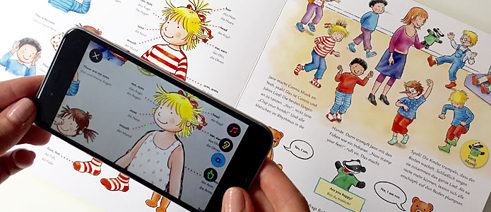Children’s books with added digital value

Some German publishers are testing digital formats for very young readers. Although the new products offer many learning possibilities, they have not yet gained widespread favour among parents and pedagogues.
Augmented reality reached German living rooms, and thus the awareness of the general public, at the latest when a large furniture manufacturer used the technology of augmented reality in its catalogues. With the app to the catalogue, virtual items of furniture can be placed in real rooms. But augmented reality is not only to be found in commercial publications, it is also used in children’s books. With its help, it is possible to add additional virtual information, such as images, videos, spoken texts or 3D objects, to visible reality. The user aims a sensor, usually a camera or scanner, at a section of his or her surroundings and a location model recognises the user’s position and two- and three-dimensional structures in the surroundings. In addition to what the user sees with his or her own eyes, further virtual information can be displayed on screen.
Bringing images to life per app
Several pioneers on the German publishing scene are aiming to take the children’s book into the future by means of this technology, among them the publishers Carlsen, Kosmos and Oetinger. What they need for the new developments, apart from capital, are creative minds. Markus Dömer has one such mind. The industrial engineer and free-lance artist has been working for Carlsen Verlag since 2011 and meantime leads a newly-established section for augmented reality there. With the series called LeYo! begun in 2014, the publisher launched a, for Germany, new product aimed at children aged five to seven. Using a smartphone or tablet, the children can scan certain parts of illustrated non-fiction books and call up so-called hotspots, that is, elements in an illustration that serve as tags for the image recognition programme. When the hotspots are called up, narrative texts, voices, sounds or songs can be played and animation appears on screen. What is more, the children can play games in which they have to recognise and collect certain objects, or else, for example, assign a certain egg to a species of bird.Learning English with the fictional character Conni
The virtual expansions of the book also offer a number of possibilities for teaching. The series includes a book for learning English with Conni, a popular children’s book character. The texts and songs were recorded with native speakers, the learners’ memory and listening comprehension are trained by means of games.New media of this kind for children, however, are still struggling for general acceptance in Germany. Many parents and pedagogues have their problems with digital formats. Markus Dömer points to Asian countries, where it is considered quite acceptable for children to own and use mobile appliances from a very early age. Parents in Germany, by contrast, still regard the book as the most serious medium. LeYo! would appear to have reached a compromise here: their book format assures parents that they have chosen the “right” offer from the wealth of such multimedia products. The “hybrid books” can be used in various ways; they are suitable for looking at and reading out loud in the classical manner, and both the book and the app can also keep children busy on their own for longer periods of time.
Pre-school children as test users
Carlsen got together a team of external colleagues for their project. From the very start, the books are conceived with a view to augmented reality. Throughout their close collaboration, editor, author, illustrator, game designer, programmer and product manager use processes and tools from the fields of games and IT. One important step in the product development is testing with pre-school children. “You simply have to let the children use them and watch what happens,” says Dömer. Only through testing with real users can difficulties in the intuitive usage be discovered. That insight is then channelled into the further conception and programming of the product.Tigerbooks Media, an affiliate of the Oetinger publishing group, has also risked taking the plunge into the digital world. Since 2013 the Hamburg company has been marketing TigerCreate, a software solution with which children’s book publishers can make an interactive e-book or app out of already existing books. Since 2015, TigerCreate has also enabled the use of augmented reality. What is more, Tigerbooks offers various publishers a joint marketing and distribution presence under the label SuperBuch. This helps to explain the concept and application of the reading innovation.
The book trade aims to participate in the process of digital change through these developments, which is why the apps are often free of charge; the client only has to buy the book. For the moment, however, small publishers are being left out in the cold, given the huge costs associated with this dynamic development.